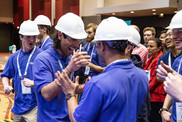|
The U.S. Department of Energy’s (DOE’s) National Renewable Energy Laboratory (NREL) has issued a Request for Proposals (RFP) and is accepting applications for the Competitiveness Improvement Project (CIP) through March 31st. The CIP is supported by DOE’s Wind Energy Technologies Office (WETO) in alignment with the office’s goals to make wind energy cost competitive with other distributed energy resources, improve interoperability with other distributed energy resources, and increase the number of wind turbine designs certified to national testing standards.
The competitive process awards cost-shared subcontracts and technical support to manufacturers of small- and medium-sized wind turbines to:
- Innovate optimized designs for increased energy production and grid support.
- Conduct turbine and component testing to national standards to verify performance and safety.
- Develop advanced manufacturing processes to reduce hardware costs.
Read more on the RFP and how the CIP supports small businesses in multiple phases of the product development cycle here.
CIP is part of DOE’s Distributed Wind program, which uses a multifaceted approach to enabling wind technology as a cost-effective and reliable distributed energy resource. To learn more about other major R&D investments in the Distributed Wind program, see the project documents linked below:

The wind industry needs a broad range of workers, including turbine engineers, project developers, and supply chain managers, to support growth in wind. Unfortunately, employers report difficulty hiring well-qualified candidates to support this growth, while graduates have also had difficulty finding jobs.
Follow these tips wind energy professionals shared to help narrow this gap and learn how to breeze into the wind energy workforce.
|
Events
March 1–4, 2020
Ernest N. Morial Convention Center, New Orleans, Louisiana
Hosted by the National Rural Electric Cooperative Association, TechAdvantage 2020 is the leading technology conference for electric cooperative professionals. Panelists include representatives from DOE and partners under the Wind Innovations for Rural Economic Development (WIRED) initiative. Register here.
March 4, 2020, 1–2 p.m. ET
DOE’s Lawrence Berkeley National Laboratory (LBNL) and National Renewable Energy Laboratory (NREL) will present a webinar of the costs and benefits of continued increases in wind turbine sizes.
In recent years, wind turbine rotors (made up of the blades and hub) have grown substantially in size. A wind turbine’s “specific power” rating is a ratio of its capacity to the swept area of its rotor in terms of watts per square meter. Therefore, for a given generator capacity, specific power declines as rotor size increases. To date, this trend toward lower-specific-power turbines in the United States has helped to boost wind’s capacity factor while also reducing its levelized cost of energy.
LBNL and NREL have recently published an analysis of the costs and benefits of this evolution in turbine design in Wind Engineering.
The webinar will present the results of this research, including how the trend toward lower-specific-power turbines affects the cost and market value of wind energy. Register here.
This work was funded by the U.S. Department of Energy’s Wind Energy Technologies Office under the Big Adaptive Rotor Initiative.
March 6-26, 2020
Launched in January by U.S. Energy Secretary Dan Brouillette, the Energy Storage Grand Challenge (ESGC) is a comprehensive program to accelerate the development, commercialization, and utilization of next-generation energy storage technologies and sustain American global leadership in energy storage. The ESGC builds on the $158 million Advanced Energy Storage Initiative announced in President Trump's Fiscal Year 2020 budget request.
The Department of Energy is hosting a series of ESGC workshops in Seattle, Austin, Chicago, and Washington, D.C., in March 2020. The workshops are an opportunity for innovators from industry and the public to learn more about the ESGC and provide input and feedback on ESGC initiatives and activities. Read more
|